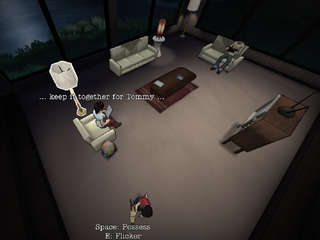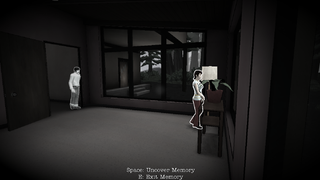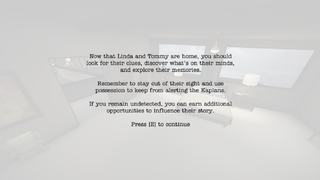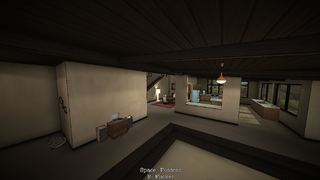'The Novelist' Game Review – You Write the Story
He may be the novelist, but you're the one who writes his story in this introspective, story-driven indie game released today on Steam.
Why you can trust Tom's Guide

There are no right answers in "The Novelist," an indie game released yesterday (Dec. 11) on Steam for PC and Mac.
Dan Kaplan is a novelist struggling with both his next book and his strained family life. He, his wife Linda and their young son Tommy have rented a house for the summer, and they hope the isolation will help them solve their individual and familial problems. But there's someone else in the house: an entity that will shape their summer and their lives. And that someone else is you.
Created by veteran game designer Kent Hudson, whose credits include "Deux Ex: Invisible War" and "BioShock 2," "The Novelist" is available on Steam for $19.99, and is also available DRM-free on Hudson's own website for the same price.
Gameplay

"The Novelist" is a stealth and exploration game. Players must move unseen through the Kaplans' summer home, collecting information on each character by reading their journals, letters and notes — and even their thoughts and memories — all without being seen.
MORE: 10 Fun, Cheap Steam Games for a Rainy Day
On Story Mode, the player is completely invisible and can move through the house with impunity, but on normal, Stealth Mode, players must stay hidden by "possessing" lamps and other light fixtures.
You're invisible when you're in the lights, but you also can't access the characters' documents or memories from those locations, and you can't possess lights that are switched off. Players can also make the lights flicker, which will cause characters in the room to examine lamps and thus create an opening for the player to slip past unseen.
You'll need to be quick, careful and a little bit lucky to gather your information without "spooking" any of the Kaplans.
In each level, or chapter, Dan, Linda and Tommy will have different goals. Collecting all of one character's papers, memories and other effects will reveal his or her current goal, and what the character needs to achieve it. The chapter ends when players choose one, and only one, of the three.
If the other two characters haven't been "spooked" by seeing you, you can also initiate a "compromise" with one of them, which will give that character a small part of what he or she wanted.
No matter what you do, each level will end with at least one disappointed character, and their setbacks and hurt feelings will carry over to the next level. It's these decisions, more than the stealth, that makes "The Novelist" a truly difficult game.
Story

In the game, novelist Dan Kaplan has written two well-received novels, but he's struggling with his third. He hopes spending the summer at an isolated lake house will help him figure out his complicated plot and actually write the book.
Meanwhile, Dan's wife, Linda, relishes the opportunity to focus on her painting, which she had put on hold to raise their son, Tommy. Linda is also worried about her marriage to Dan: her journal entry at the start of the summer reveals they have been growing apart. It'll take effort on both Dan and Linda's parts to reverse course.
Tommy, meanwhile, is a quiet child who has been seriously bullied during the school year. This summer vacation means his tormentors are far away, but so are his friends, and any other kids his age. Tommy also struggles with a reading disability and needs his father's help to get on pace with the rest of his class before he returns to school in the fall.
That's where you, the player, come in. Each player takes the role of a spirit or other supernatural force that seems to haunt the house. The game never really explores the spirit's own backstory, although, between chapters, players can find journals in which former tenants have recounted the strange "tricks of the light" they see, or the "suggestions" that don't seem to come from their own minds.
The spirit "helps" the Kaplans by listening in on their private affairs, determining the choices the family faces and then whispering suggestions into Dan's ear as he sleeps.
The game is divided into three acts, which correspond to the three months of the family's vacation. Each act contains three chapters, or days in the family's life, in which Dan, Linda and Tommy's desires prove irreconcilable.
Dan needs to get a draft of his book finished, but Tommy wants to play board games with his father, and Linda is hoping Dan will find time to share a bottle of wine and talk with her, like he used to. Whether the characters get what they want depends on what the spirit (i.e., the player) chooses for them.
Art/Graphics

The game's artistic style is consistent both with itself and with the story told in its landscapes, using straight lines and solid but subdued colors to echo the quiet isolation of the Kaplans' daily lives in the house. Only the characters' faces, little more than lines scratched into the front of their heads, can be off-putting, but luckily, if you stay hidden and don't "spook" them, you'll rarely see their faces.
What the game lacks in facial animation, it more than makes up for in body language. During the day, the characters roam the house, but their movements aren't random. You'll rarely find Dan in Linda's painting room, or Tommy in his parents' room.
MORE: 10 Most Graphically Stunning Games of All Time
Dan spends most of the time in his office; Linda spends more time with Tommy. Characters' movements are always smooth and realistic-looking, and each one has his or her unique quirks: Dan at his typewriter, Linda at her easel, Tommy sprawled out on the floor with his toys.
It's when players enter a character's memories that Dan, Linda and Tommy seem to truly come to life, even though they don't move. In memories, characters are arranged like a tableau — leaning on walls, peering through doorways, curled in a corner — their body language far louder than the snippets of conversation they echo. The care with which the character models were arranged for these scenes is clear, and it's powerful.
Music/Audio
A soft, slightly eerie atmospheric piano melody plays in the background during the day, underscored by the sound of ocean waves from just beyond the house's yard. Other household noises play throughout the day as well, but Dan's typewriter dominates the soundscape with its steady clicks or conspicuous absences.
When the characters speak, however, sound design really starts to matter. Dan and Linda read their letters aloud in their own voices, and the performances of the excellent voice actors bring emotion to the already-revealing words on the page.
Replayability

In the playthrough for this review, each character received the same amount of wins and compromises. Whoever got nothing in one chapter got a compromise in the next, and whoever had to settle for a compromise in one chapter got their desire in the next.
But what would happen if players favored one character exclusively over the other two? What if one character was totally neglected?
The many possible paths and endings in "The Novelist" encourage multiple playthroughs. However, the slow pace might discourage some from doing so, as it takes two to four hours to play completely through the game each time.
Verdict
There are no heroes in "The Novelist," and no winners. There are only people who want what they want and have a hard time understanding why they can't have it.
As the spirit that haunts the family's vacation house, your strange, supernatural influence over Dan's decisions only lasts three months — just a few hours in terms of gameplay — but the game does an excellent job of making the player feel as though each choice will affect an entire life.
If you like story-driven or experimental games, you won't want to miss "The Novelist."
Minimum Requirements:
OS: Windows SP2 (minimum) / OS X Lion (10.7)
Processor: 1.8 GHz
Memory: 2 GB RAM
Graphics: 256 MB VRAM video card (minimum)
Hard Drive: 800 MB available space
Email jscharr@techmedianetwork.com or follow her @JillScharr and Google+. Follow us @TomsGuide, on Facebook and on Google+.
Sign up to get the BEST of Tom’s Guide direct to your inbox.
Upgrade your life with a daily dose of the biggest tech news, lifestyle hacks and our curated analysis. Be the first to know about cutting-edge gadgets and the hottest deals.
Jill Scharr is a creative writer and narrative designer in the videogame industry. She's currently Project Lead Writer at the games studio Harebrained Schemes, and has also worked at Bungie. Prior to that she worked as a Staff Writer for Tom's Guide, covering video games, online security, 3D printing and tech innovation among many subjects.
